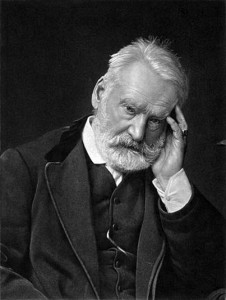There are numerous standard-bearers of the romantic movement in literature. However, the french writer Victor Hugo represents the movement as whollistically as any romantic figure.
Victor Hugo by Comte Stanisław Julian Ostroróg dit WALERY, used under ![]()
Hugo was born in Besançon, France in 1802 and lived until 1885. Hugo found romanticism early in his literary career and quickly became a leading voice in the movement. He believed strongly in the idea that “the author’s creative spirit is more important than following the rules and past traditions” (The Romantic Victor Marie Hugo, n.d.).
The Hunchback of Notre Dame was published by Hugo in 1830. Hugo was a staunch supporter of equality in society and politics, and Notre Dame reflected this. Hugo used this novel to criticize the inequalities he felt were present in society. Hugo’s work also presented a story that “drew upon recent French history rather than the oft used ancient Greek and Roman history of neoclassicism” (Novikoff, n.d.).
In this instance, Hugo is a figure of revolution based on his advancement of romanticism at the expense of neoclassicism. Hugo clearly felt a sense of hopelessness with the direction of French culture at the time. He expressed this hopelessness in the form of a novel critical of the power structure that modern France was regressing towards. Hugo also enjoyed an immense rise in popularity for his novel, spreading his pro-republic agenda throughout society. “Young France only waited now a leader to carry this cry… some resistless genius, some Napoleon of letters, to lead on to victory. The leader was found in Victor Hugo” (Cooke, 1902).
Following his rise in popularity, Hugo entered himself even further into the political landscape (Victor Hugo — A Brief Summary of his Life, n.d.). Hugo wanted to maintain order as much as possible in France. He originally supported the candidacy of Louis Bonaparte, but after considering his monarchial leanings, he vehemently opposed his rule. Following Bonaparte’s rise to power, Hugo fled the country and ended up in Brussels.
While in Exile, Hugo published numerous works that criticized Bonaparte’s rule and expressed his feelings on social equality (Victor Hugo — A Brief Summary of his Life, n.d.). Les Misérables was arguably the most notable of Hugo’s works to come from this time. This novel is another representation of revolutionary literature.
Napoleon III
by Alexandre Cabanel, used under ![]()
Les Misérables also exemplifies the expression of hopelessness in literature. During his exile from France, Hugo revolted against the French government through his literature. Hugo used the widening income gap between the rich and poor and the worsening conditions for the working class as rallying cries in Les Misérables (Haven, n.d.). His novels continued to be popular among the French people, and his voice influenced the masses. Although Bonaparte was the cause of his own undoing, Hugo contributed to the revolution in thought that ultimately chipped away at his popularity. It was this groundswell of dissent from Bonaparte’s camp that led to his reformation of the French government and a shift towards a republic model.
References:
Cabanel, A. (1865). Napoleon III. [Painting]. http://blogs.butler.edu/sp14group9/files/2014/04/Alexandre_Cabanel_002.jpg. Available under Public Domain.
Cooke, A. (1902). Victor Hugo’s Message to His People . The Sewanee Review , 10 (2).
Haven, C. (n.d.). Enjoy Les Misérables. But please get the history straight. . (Stanford University) Retrieved April 12, 2014, from The Book Haven.
The Romantic Victor Marie Hugo. (n.d.). Retrieved April 7, 2014, from History 255 Presents: The France of Victor Hugo.
Novikoff, A. (n.d.). Medievalism and Modernity in Victor Hugo’s Hunchback of Notre Dame. (Rhodes College) Retrieved April 8, 2014.
Victor Hugo — A Brief Summary of his Life. (n.d.). Retrieved April 9, 2014, from States of Guernsy.
Walery, C. S. (1875). Victor Hugo. [Painting]. http://commons.wikimedia.org/wiki/File:Victor_Hugo.jpg. Available under Public Domain.


